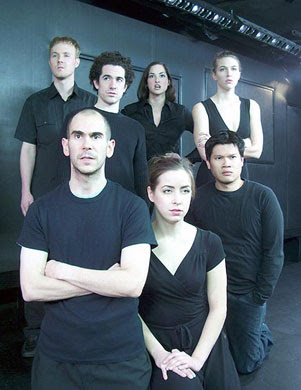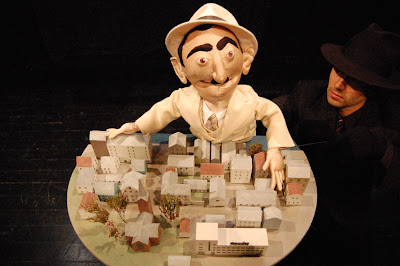Lower Ninth

Right from the start, you can tell Gaius Charles is a TV actor. As Malcolm (a fierce but too often overcooked James McDaniel) cries out evangelically over a trash-bag wrapped corpse, Mr. Charles (who plays Malcolm's malcontent son, E-Z, aka Ezekiel) chews up the stage with big rolling eyes, a tilted head of disapproval, and a clenched lip -- not at all to the benefit of the man he's standing atop a dilapidated roof with, but so that we, the audience can see that he's not happy to be there. As if things weren't obvious enough in Beau Willimon's uneven new play, Lower Ninth.
Ignoring the problems with the set (the roof is set at floor level, the lights are smooth, and the room is quietly air-conditioned, none of which allow us to imagine the wake of Hurricane Katrina), and the issues with Mr. Charles's physicality, the first half of Lower Ninth is a pretty good play. Malcolm, who is attempting to atone for his reckless abandonment of E-Z, has come back at just the right time, and with the two of them stuck on a roof with nothing but a corpse, they've got plenty of time to catch up. The script flows easily through biblical interpretations (Noah's ark offers an explanation for where white people came from), anecdotes about hardness (E-Z becoming the accidental king of an island), and character-revealing games of 20 questions, and both Mr. McDaniel and Mr. Charles have a fine way of bristling at one another, the former holding on to a newfound sainthood, the latter holding on to his survival-instinct anger.
But then, after a quiet moment in the darkness, the lights come on to reveal the corpse, Lowboy (Gbenga Akinnagbe), playing with a lighter. He admits that he's "worm food," and it's obvious that the scene is half-hallucination and half-E-Z's guilt, but the entire scene must've been cooked up by a Beau Willimon spending too much time out in the sun: everything that passes between them is either reductive of the present circumstances -- as when Lowboy predicts E-Z's future death -- or redundant, as when Lowboy reminds E-Z of the difference in their street cred, and how all that means absolutely nothing if you can't swim. There's some funny lines ("My granma could've held that corner in her walker"), but it's not real, and Lower Ninth, dealing with such tragedy, needs to be real.
And speaking of real, that's where Daniel Goldstein faces some critique as a director. It's not just Donyale Werle's set that looks fake and -- worse still -- safe; it's the staging, too. In one scene, actors are complaining of the worst effects of dehydration, in the next, they're bouncing around, climbing up onto the chimney, or stripping of their shirts in the baking heat, preparing to dive into poisonous water. If as much time is passing as the shifting sun of Ben Stanton's lighting would have us believe, then these characters should be getting less energetic and more serious as the play continues, and instead, the opposite happens. Hell, what should be the peak of drama -- a father hydrating his son by force-feeding him blood -- comes across as the stuff of soaps, only with fewer repercussions, seeing as the play has only eighty minutes to wrap itself up.
It's hard to make sense of why it took so long for disaster relief to reach New Orleans, and I admire that, for the most part, Lower Ninth focuses on faith and family rather than on blame. But the only feeling of circumstance comes from the script, not its characters or its design, which makes going to see Lower Ninth akin to heading off to New Orleans only to keep one's head buried in a book the whole time. I saw this play, but it sure doesn't feel like I was really there.

















